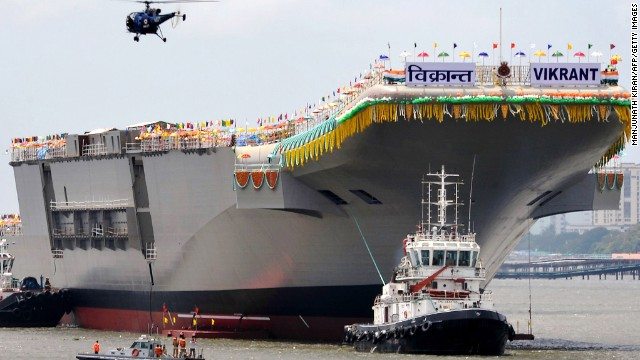India’s new indigenous aircraft carrier (IAC), the INS Vikrant, has been floated out of her building drydock and towed over to a fitting-out quay for the final steps in her construction. She is due to be delivered to the Indian Navy in late 2016. Sea trials will commence in 2017 and last two years before she is formally inducted into service.
This is actually the second time the Vikrant has been floated out. The completed hull of the Vikrant was originally floated out of her dry dock at Cochin Shipyard on December 29, 2011. Work was then delayed when the main reduction gearing for the powertrain, made by the Gujarat-based Elecon Engineering Company Ltd, was found to be non-compliant with the specifications.
This is a key item, since the reduction gearing is a very heavy and cumbersome part of the powertrain and replacing it essentially involves dismantling the aft part of the ship. Accordingly, construction of the Vikrant was suspended while a new reduction gear assembly was built. This became available in early 2013, with the ship then being returned to a dry dock for the installation of her propulsion and power-generation systems.
The INS Vikrant is powered by four General Electric LM2500+ gas turbines, 29,500 shp each. The ship can reach speeds of 28 knots (52/km/h; 32 mph).
The contract to build a 65,000-tonne follow-on to the Vikrant has yet to be signed, since the delays in building Vikrant have derailed the finely balanced construction timetable.
All the Indian Navy’s aircraft carriers to date have been built abroad. The original INS Vikrant and the INS Viraat were both originally British light fleet aircraft carriers that were purchased from the Royal Navy. Vikrant was scrapped some years ago while Viraat is barely operational and due to be decommissioned this year. The newest aircraft carrier, INS Vikramaditya, was originally the Russian Admiral Gorshkov and was procured by the Indian Navy after a very long and expensive reconstruction.
The Indian Navy has settled on a fleet of three carriers, this being enough to maintain a fleet of two ships in service, with a third undergoing maintenance and refit, at any one time. The two operational ships can then be deployed, one on each coast. Thus, even the very expensive and technically questionable Vikramaditya will have an important role to play in building the carrier fleet up to three ships, and the Indian Navy will get at least a decade’s service out of her. Even after the three Vikrant class carriers are in service, Vikramaditya will have a role to play as a training carrier.










